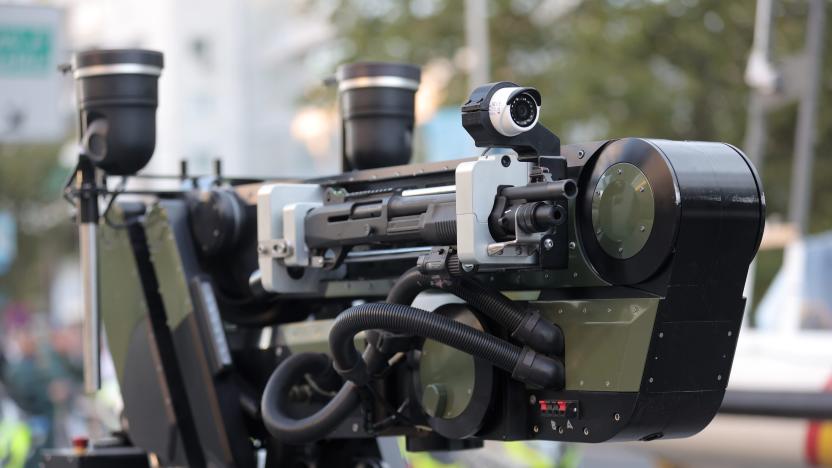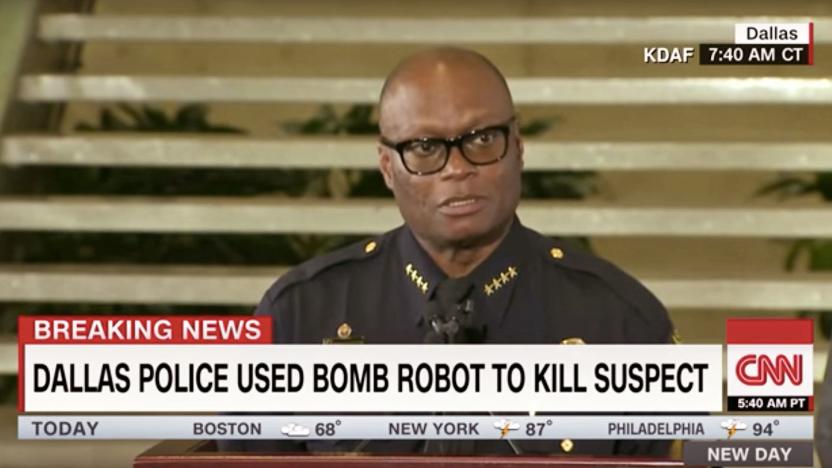bomb
Latest

San Francisco police seek permission for its robots to use deadly force
The San Francisco Police Department is currently petitioning the city's Board of Supervisors for permission to deploy robots to kill suspects based on whether an officer feels threatened.

Venezuela says Maduro was target of attempted drone attack (updated)
Venezuela President Nicolas Maduro may be the first major leader to have faced a drone-based assassination attempt. Information Minister Jorge Rodriguez claimed that at least one bomb-laden drone had exploded close to Maduro while he was giving a speech at a Caracas event on August 4th. The authoritarian leader was unhurt in the incident, but seven National Guard soldiers were reportedly injured. Video from state TV showed Maduro and officials looking up in a moment of panic before the camera cut away, with the assembled troops running soon afterward.

In nuclear politics, one size doesn't fit all
No one wants to use nuclear weapons. Even President Harry S. Truman, the only leader in history to actually order and carry out a nuclear strike, was hesitant to use the United States' atomic arsenal after witnessing the power of the bombs first-hand. On July 16th, 1945, the US successfully detonated the world's first atomic warhead, an implosion-type plutonium bomb that transformed the New Mexico desert into radioactive green glass. Six days later, President Truman wrote in his journal: "We have discovered the most terrible bomb in the history of the world. It may be the fire destruction prophesied in the Euphrates Valley Era, after Noah and his fabulous Ark. ... This weapon is to be used against Japan between now and August 10th. I have told the Sec. of War, Mr. Stimson, to use it so that military objectives and soldiers and sailors are the target and not women and children."

iPad bomb threat led to recent device ban on flights
When the US and UK banned people from carrying large devices aboard flights originating in the Middle East and northern Africa, they only made vague claims about this being in response to threat reports. But just what were those threats, exactly? We might have an idea. A Guardian security source understands that the bans were prompted in part by a plot to tuck explosives into a fake iPad. This wasn't the only motivation -- there was a "combination of factors," according to the newspaper -- but it played an important role. It's not clear where and when this faux tablet bomb would have been used.

Facebook Safety Check erroneously says a bomb exploded in Bangkok (updated)
Facebook's Safety Check program incorrectly said there was an explosion in Bangkok, Thailand, The Independent reported. For an hour beginning at 9PM local time on December 27th, anyone in Thailand's capital city saw reports of an explosion and a prompt to mark themselves as safe. However, there was no actual bomb explosion in Bangkok tonight.

Samsung blocks video of 'GTA V' Galaxy Note 7 bomb mod (updated)
Samsung's Galaxy Note 7 has been the butt of its fair share of internet jokes since it started exploding in September, but it's hard to surpass what one Grand Theft Auto V modder did when he turned the phone into an in-game grenade. Apparently, Samsung doesn't think it's very funny, though -- the company appears to have filed a totally bogus copyright infringement claim on the YouTube video showing this mod.

Dallas' bomb robot sparks debate around police militarization
"We saw no other option than to use our bomb robot." Camera shutters clacked as Dallas Police Chief David Brown told a crowd of reporters how his department killed a suspect after a shooting spree that left five officers dead and seven more wounded Thursday night. Law enforcement and a hostage negotiator cornered the suspect and attempted to talk him down for several hours; they learned that he was upset about recent fatal police shootings of black men around the nation and that he "wanted to kill white people, especially white officers." Officers and the 25-year-old man ended up exchanging fire. After hours of attempted negotiations, a police surveillance robot armed with a bomb on its extending arm rolled onto the scene. The explosive was detonated in the man's makeshift bunker, and he died in the blast. "Other options would have exposed our officers to great danger," Brown said.

Saab built a robot to stop underwater terrorist bombs
The US isn't just worried about terrorist bombings above-ground -- it's concerned about bombs below the waves, too. To that end, it's working with Saab on a remotely-controlled underwater robot, the Sea Wasp, that's designed to deal with improvised explosives. The machine (a smaller take on the existing Seaeye) uses a mix of sonar and a manipulator arm to find, move and sometimes disable explosives. Its party trick is its sheer maneuverability. It can hover in virtually any position, helping it dispose of bombs even when they're attached to a ship's hull.

Optical nanotech sensor can sniff out bad food and explosives
The days of having to rely on pricey lab sensors (or carefully trained canines) to detect bad food and bombs may soon come to an end. Oregon State University researchers have developed a hybrid optical and nanotechnology sensor that's at once super-sensitive to gas, but won't weigh a ton or cost a fortune. It uses a super-thin, metal-organic film to absorb the gas, and magnifies the telltale chemical signals using low-cost plasmonic nanocrystals that act like miniature optical lenses. It's best-suited to watching out for carbon dioxide (helpful for businesses that want to fight greenhouse gases), but it can detect a "wide range" of materials.

Super-sensitive chip can sniff out bombs from 16 feet away
Let's face it: the theatrical security procedures at airports aren't going away any time soon. However, they might just get more tolerable if a team of Israeli researchers bring a new, extremely sensitive bomb detection chip to an inspection line near you. The prototype sniffs for explosives by using groups of nano-scale transistors that react to tiny electrical changes when certain chemicals pass by. And we do mean tiny -- the chip can raise alarms if there are just a few molecules found out of 1,000 trillion. For those not keeping score, previous techniques will 'only' raise a red flag in the molecules per billion range.

Drones help find World War II's missing soldiers
The BentProp Project has spent years finding American soldiers who went missing in the Pacific during World War II, but available technology has limited its success. Team members have frequently had to scan wide areas themselves, slowing down their efforts to find downed aircraft and unexploded bombs that might hide human remains. However, the outfit's searches have just taken a big step forward after it got cutting-edge drones from both the Scripps Institution of Oceanography and the University of Delaware. BentProp can now automate much of its scanning, and CNET notes that the organization's latest expedition found two Navy airplanes. That's a breakthrough for a group that only occasionally makes a big discovery.

Keep Talking and Nobody Explodes is local bomb-defusing fun
Three developers at Algonquin College in Ottawa, Canada recently offered a novel multiplayer bomb-diffusing game for this past weekend's Global Game Jam. Dubbed Keep Talking and Nobody Explodes, the game has one Oculus Rift-wearing, Razer Hydra-holding player lifting and examining a ticking time bomb while at least one other player holds the manual with instructions to disarm the virtual destructive device. The accompanying video for the game shows three fellows hovering over a spread of papers, shouting instructions (and not always the correct ones) at the bomb's diffuser with choice quotes like "Oh fuck," and "How much time is on the bomb, Owen?" Developed by the team of Allen Pestaluky, Ben Kane and Brian Fetter with dramatic music by Liam Sauve, the Windows-only game is freely available for players to check out on the Global Game Jam website. Kane works with Going Loud Studios, developers of the satirical platformer DLC Quest. Keep Talking and Nobody Explodes requires the Oculus Rift and Razer Hydra devices, so the rest of us will have no choice but to pray others will snip the correct wires.

Irish government seeks emergency power to cut mobile services during G8 summit
The Irish Defence Minister, Alan Shatter, has put forward a law that would give his government the right to cut off mobile services "in a limited area" to prevent a bombing. In particular, he fears that militant groups may attack next month's G8 summit in Northern Ireland to "garner publicity," and that they may try to detonate explosives remotely using phone signals. Ireland already has a voluntary system for requesting operators to suspend services if there's a threat, but the new legislation would make this compulsory, in case the authorities should face any "difficulty in getting a telecom company in an emergency to cooperate." The idea of deliberate blackouts may sound strange, at least outside of oppressed nations like Egypt and Syria, but Shatter says the Boston Marathon bombing, which possibly also involved cellphones as detonators, proves that such measures are necessary.

Former EVE CSM member Vile Rat killed in attack on Libyan consulate [Updated]
All too often, we read news of conflict in other countries with an impersonal detachment, as if it's so far away that it will never touch our lives in any significant way. Mainstream media twists each event into a political message with the same detachment, forgetting the reality of the lives that are destroyed every day. This morning that fact was brought home as we read news of a US official killed in an attack on the Libyan consulate in Benghazi. Just a few hours ago, EVE Online alliance GoonSwarm released a statement that the US official killed was apparently GoonSwarm director and former Council of Stellar Management member Sean "Vile Rat" Smith. Players, CCP developers, and GMs have begun leaving their condolences on the official EVE forums. According to those who knew him, Vile Rat was a well-loved player and a respected leader whose actions indirectly touched the lives of every EVE player. Massively extends its own condolences to his family and friends. [Update: In the time since this story was published overnight, the BBC has updated its coverage, noting that a total of four Americans were killed in the attack, the US Ambassador to Libya and Sean Smith among them.]

Explosion-proof flashlight could be the first to outlive its owner
You know the drill, walking through that mine field, only to lose another good flashlight when you drop it on one of those puppies. Well if this is a concern of yours, the EXP-LED-51 from Larson Electronics should see you right. The latest in its like of hazardous location devices, the rugged LED torch is rechargeable, has 180 lumens of output and rated for 50,000 hours of service in the (dark) field (480 hours on one charge in the lowest power mode). For the man (or woman) on the move, the EXP-LED-51 also comes with a 12V car charger, as well as the standard VAC outlets. How much for this level of resilience? That'd be 320 bulletproof dollars.

iRobot 110 FirstLook hands-on (video)
iRobot's Bedford, Massachusetts headquarters is literally crawling (well, rolling) with robots of all shapes and sizes, from friendlier household fare like Scoobas and Roombas, to the 450-pound Warrior battlefield 'bot, which patrols the perimeter, looking for mock IEDs. The highlight of our trip this week, however, had to be the time we spent with 110 FirstLook. Sure, durability is job number one, when you're building products for the military, but the plucky little robot takes things to a whole new level. At five pounds, you can pick the thing up and toss it -- in fact, the company encourages such action. The FirstLook was built to be thrown into dangerous areas, and it's rugged enough to smash through plate glass windows to get there. The 'bot has a patch of skateboard-like grip tape on its top, opposite the bendable antenna, so you can easily grab it with a single hand. You toss the FirstLook side arm, like a frisbee, and no matter what side it lands on, the rubber treads will cushion the blow a bit. If it happens to hit the ground upside down (with the antenna on the bottom), the triangle wings on either side can be slowly extended in either direction to right the robot. Same goes for when it bounces down a flight of stairs, unharmed.

Fallen Earth lays the foundation for 2012 in its January state of the game address
Senior Game Designer Marie Croall sounded the klaxons and ran up the flag for the wastelanders of Fallen Earth in the latest state of the game address. For her and the team, it's time to shake off the ravages of holidays and get to work on laying the foundation for the game in 2012. Croall says that this month players should expect to get the ability to use bombs in Territory Control, which should change things up somewhat. The Territory Control PvP feature will be significantly expanded in the months afterward as well. Also on tap for the near future are additional mid-level quests, the augmentation system for customizing gear, improving the flow of starter areas, and better rare drops across the board. The art team is excited to move on to giving Haven a facelift much like the work the team did on the recent Embry Crossroads revamp. Perhaps the most intriguing is that Croall hints at a major top-secret project in the works: "This month we're also breaking ground on one of the biggest systems we've ever done. It's still too early to really get into details on but we'll make sure this one was worth waiting for."

Researchers use inkjet acumen to create wireless explosive sensor from paper
Meet Krishna Naishadham and Xiaojuan (Judy) Song. They're researchers at the Georgia Institute of Technology, and those little devices they're holding may one day save you from an explosive device. This petite prototype is actually a paper-like wireless sensor that was printed using basic inkjet technology, developed by professor Manos Tentzeris. Its integrated lightweight antenna allows the sensor to link up with communication devices, while its functionalized carbon nanotubes enable it to pick up on even the slightest traces of ammonia -- an ingredient common to most IEDs. According to Tentzeris, the trick to such inkjet printing lies in the development of "inks" that can be deposited at relatively low temperatures. These inks, laced with silver nanoparticles, can then be uniformly distributed across paper-based components using a process called sonication. The result is a low-cost component that can adhere to just about any surface. The wireless sensor, meanwhile, requires comparatively low amounts of power, and could allow users to detect bombs from a safe distance. Naishadham says his team's device is geared toward military officials, humanitarian workers or any other bomb sniffers in hazardous situations, though there's no word yet on when it could enter the market. To find out more, careen past the break for the full PR.

Mesa Robotics' mini-tank is perfectly happy on point (video)
The Acer ground-bot from Mesa Robotics does way more than your average 4,500-pound semi-autonomous mule. In addition to carrying kit and providing that extra bit of ballistic steel-deflecting cover, it also scans for IEDs using ground-penetrating radar and then autonomously switches into "flail" mode when it finds one -- digging up and detonating that critter with barely a break in its 6MPH stride. Did we mention it also acts as a landing pad for small drones? No? That's because the video after the break says it all. Cue obligatory guitars, game controllers and armchair gung-ho.

New bomb-sniffing laser could be used to locate IEDs
We've already seen lasers with the potential to spot explosives, and now a team of researchers is focusing its beams on roadside bomb detection. Chemistry professor Marcos Dantus of Michigan State University has led the production of a laser that has the "sensitivity and selectivity" to accurately identify improvised explosive devices. This particular bomb-sniffing laser emits short pulses that make molecules vibrate and longer pulses used to "listen" to the resulting "vibrational cords," these so-called cords are used to distinguish telltale molecules from the harmless sort. The research is being funded in part by the Department of Homeland Security. Full PR after the break.











